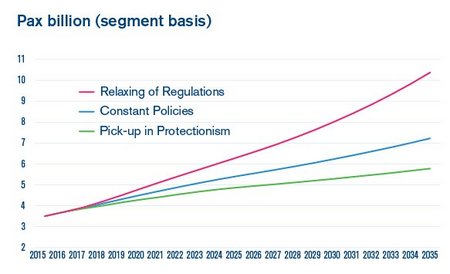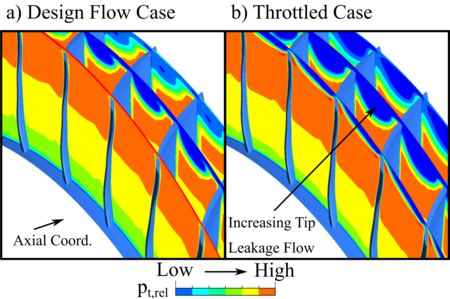Basics
| Call Identifier: | H2020-CS2-CFP07-2017-02 | |
| Project Nr.: | 821435 | |
| FloCoTec: | Flow Control Techniques Enabling Increased Pressure Ratios in Aero Engine Core Compressors for Ultra-High Propulsive Efficiency Engine Architectures |
Description
The continuous growth of the air transport sector provides both benefits and challenges for the aviation industry. Even in the most pessimistic scenario, the number of annual passengers is expected to grow to 5.8 billion by the year 2035 (cf. Figure 1).

This implies a compound average growth rate of 2.5% annually and will further increase the impact of aviation on the environment, thus, leading to a high demand for more environmental friendly and more economic aircraft engines. Together with the future standards and goals set by the aeronautical community this requires aero engine manufacturers to realise more advanced aircraft engine concepts. Many national and international institutions and programmes, such as Clean Sky 2 Joint Undertaking of the European Union, support the efforts of the aviation industry by promoting the development of novel gas turbine technologies that enable the minimisation of an aircraft engine’s NOx, CO2, and noise emissions as well as fuel burn (cf. Table 1).

To reduce the environmental impact and enhance the overall efficiency of an aero engine, thermal efficiencies need to be increased. The geared turbofan concept investigated by SAFRAN Aircraft Engines within CS2 is set to develop an ultra-high-propulsive-efficiency engine architecture and ground test demonstrator, where an increase of the core engine pressure ratio will improve the engine’s thermal efficiency. However, a further increase in core engine pressure ratio leads to an inevitable reduction of the core engine size and cross sectional area, which introduces new HPC design challenges, particularly for the compressor rear stages. Since the rotor tip and stator seal clearances are limited on an absolute scale to avoid rubs, a decrease in blade height results in larger relative blade clearances, which lead to increased secondary flow phenomena, including stronger blade tip vortices (cf. Figure 2), shroud leakage flows, and an increased boundary layer growth in the endwall regions.

These detrimental aerodynamic effects penalize the operational behaviour (stall margin) and aerodynamic performance (efficiency). To overcome the detrimental effects arising from pronounced rotor tip leakage flows, casing treatments (CT) are commonly applied. However, while CTs are known to strengthen the flow in the rotor tip region, they typically cause a radial re-balancing of the flow and weaken the downstream compressor flow at lower span heights. This phenomena will be particularly pronounced within the compact rear stages of future high pressure ratio HPCs with small blade heights, and considerably increases the risk of a premature compressor stall due to weaker flows at lower span regions. To tackle these aerodynamic challenges, General Electric Deutschland (GEDE) investigates innovative HPC technologies including an advanced 3D blade design for HPC rear stages within the CS2 Joint Undertaking. TUM-LTF aims to contribute to the research of GEDE through:
- The development of compressor flow treatment technologies that strengthen the flow across the entire span, enhance the stability in a multi-stage compressor environment, and maximise the potential of the CT-technology.
- The provision of a compressor rig test facility that allows for a validation of the HPC rear stage technologies developed by GEDE and TUM-LTF, including a detailed quantification of the HPC performance and operability, under engine representative conditions.
- The development and application of advanced unsteady pressure and temperature measurements that allow for a time-accurate entropy estimation and thus provide a detailed understanding of the flow physics and aerodynamic loss mechanisms within the developed HPC rear stage concept.
TUM-LTF’s year-long experience in the development of compressor flow treatment technologies, particularly its expertise in CT-design, as well as the institute’s unique high-speed-research-compressor rig and its demonstrated HPC-testing experience ensures that the findings of FloCoTec will help GEDE to develop an innovative HPC rear stage concept for next generation high pressure ratio compressors in future UHPE-like aero engines.


